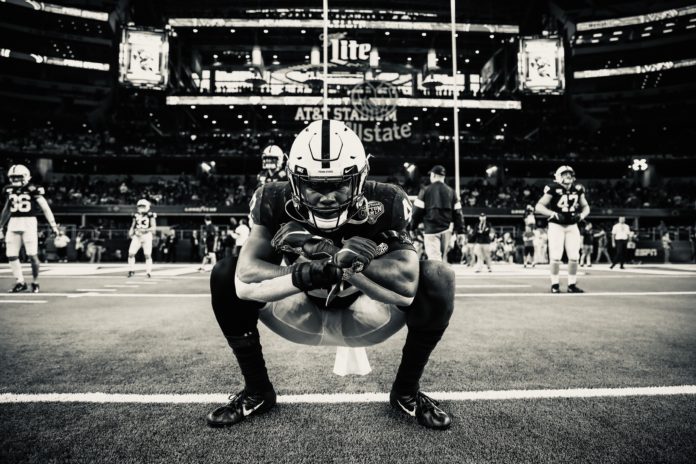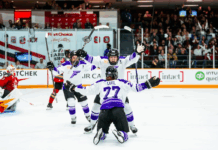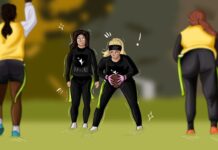‘I hear a ringing bell’
In the intensity of the football game, Jesse Luketa was sprinting towards the ball carrier to make a tackle when – to his surprise – he was hit. The side of his head struck a blow from a blindside blocker from the opposing team.
Luketa was taken off the field immediately.
“I knew from that point that something was wrong, and I told my coach that I hear a ringing bell,” Luketa said.
When Luketa was about 12-years-old – before being drafted by the Penn State Nittany Lions – he experienced something that many football players go through – a concussion. At the time, the athlete was playing for the South Ottawa Mustangs.“You try to regather as fast as possible, but you know something’s wrong, but you don’t know what exactly it is.”
‘A kill or be killed mentality’
The former head football coach for the University of Ottawa Gee-Gees, Jamie Barresi, reflected on the education around concussions when he was playing football.
“It was in an age where you just told somebody ‘just walk it off and go play the next play,’” he said.
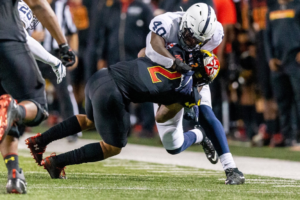
Barresi explained that there was not a lot of awareness about concussions when he was playing the sport.
“It was nothing to tell somebody to ‘suit up’, full pads, and go at it again after a major collision. There was no type of measurement as to what type of traumatic load there would have been.”
Now, whenever one of Barresi’s players endures a hit which raises a red flag, they are pulled from the field right away. Athletes are then assessed based on a numerical scale, which indicates if they need to go into an incubation period, which is a no play period, about two weeks long.
According to Megan Stewart, an athletic therapist at the University of Ottawa, the Gee-Gees use the Sport Concussion Assessment Tool (SCAT). It is a tool to evaluate the varying symptoms of a suspected concussion.
Sometimes athletes between the ages of 17 to 24 cannot distinguish the difference between a concussion and dehydration, according to Stewart.
“They drink water and they feel better and they’re young, so they kind of spring back or they lie to you, which is a very big thing. I personally hate concussions, because I have to rely on what the patient tells me,” she said.
Stewart said she almost prefers receiving patients with concussions when they have been knocked unconscious or have a blown pupil because she is able to rely on the physical symptoms for diagnosis. Otherwise, she said that concussions can be difficult to diagnose, especially when patients are not honest about how they are feeling.
From Luketa’s perspective, in the whirlwind of a game, “you would never know” he was hurt after being hit.
“It’s a part of the game, especially competing at the level at which I’m playing at now, that’s how it has to be. It’s either that or it’s giving someone else the opportunity to make plays,” he said. “It’s honestly a kill or be killed mentality.”
A quick recovery

After resting for one day, Luketa returned to school. He was back on the field within one week. But two years later, Luketa had the same experience.
This time it was the District 10 semi-finals and he was playing for Mercyhurst Prep in Erie, Pennsylvania. During the kickoff, Luketa ran at the ball carrier and tackled him, but his head rammed into the opposing player’s hip. His head ended up taking all the impact.
“When I got up, I was a little wobbly and I didn’t want to say anything, but my trainers, they could tell by the way I got up and how I responded to the contact and the way I was walking that something may have been wrong,” Luketa said.
Nick Westcott, a strength conditioning coach at Carleton University, said concussions are stressful for athletes, and can require long-term recovery periods.
Luketa returned to play within one week, for both concussions. This is the minimum amount of time required to return to one’s sport, according to Jacquie van Ierssel.
Van Ierssel is a postdoctoral fellow with a pediatric emergency concussion research team at the Children’s Hospital of Eastern Ontario.
The threat of repetition
Luketa has had two documented concussions and is unsure if he has had others. The athlete explained that sometimes after getting hit in the head, players simply continue to play.
According to van Ierssel, this is called a subconcussive impact, which is a hit that is not severe enough to bring on concussion symptoms. However, the threshold for a subconcussive impact is still unclear, she explained.
According to her research, 50 per cent of concussions are not reported.
Clara Karton is a postdoctoral researcher in human kinetics and health sciences with a focus on the biomechanics of head injuries at the University of Ottawa. Based on her research, she said the repetitive nature of these hits and that constant trauma could potentially cause damage if overlooked.
“People could not feel great or have a bit of a headache or minor symptoms, not reported, but there’s still something occurring,” Karton said. “Just because we don’t necessarily feel it or report it, doesn’t mean that it’s not there.”
Potential prevention
The Carleton Ravens football team uses isometric neck training as a preventative measure, among other things. Through these exercises, players can control how much pressure they put on their head, according to Westcott.
“The value of isometric neck strength, potentially, is your ability to stabilize and keep your head stable when you receive a hit,” he said.
“When the time comes during the game, and I get hit and my neck snaps, it’s nothing new,” said Luketa when discussing neck strengthening.
There is no current evidence to suggest strengthening the neck prevents concussions, according to van Ierssel Overall, there is nothing football players can do to prevent concussions at all.
Even helmets and mouthguards, no matter what kind, do not prevent concussions, she explained. This is because concussions occur when the brain undergoes a stretch strain force within the skull.
“Concussions are the symptoms, and the injury itself is more at a cellular level,” Karton said.
“Across all levels, including the CFL, they’ve gone to reducing the full-contact practice … because we know that if you reduce contact practices, you reduce the risk of head impact,” van Ierssel said.
Unfortunately, she explained that researchers do not know if contact reduction in practices is actually reducing the overall number of injuries because most concussions happen in games.
The lack of evidence
“We currently don’t have a perfect diagnostic test for concussions. There’s no one single test that by itself can diagnose a concussion,” van Ierssel said.
Due to this, diagnosis is primarily based on self-reported symptoms, she explained.
When it comes to symptoms, “sometimes people don’t have them, sometimes people don’t report them and sometimes people have a very strong reaction that lasts a long time,” Karton added.
Van Iersell explained that they think underlying recovery happens beyond the time it is possible to measure it.
“We have a number of clinical assessment tools, like neurocognitive testing, balance testing, symptom testing, and they look normal, even when there’s some evidence that the person hasn’t recovered yet,” she said.
Why Luketa continues to play
Luketa now plays at the Division One level for the Penn State Nittany Lions. He understands the risks of playing a collision sport, but his love and passion for football keeps him coming back even after experiencing injuries.
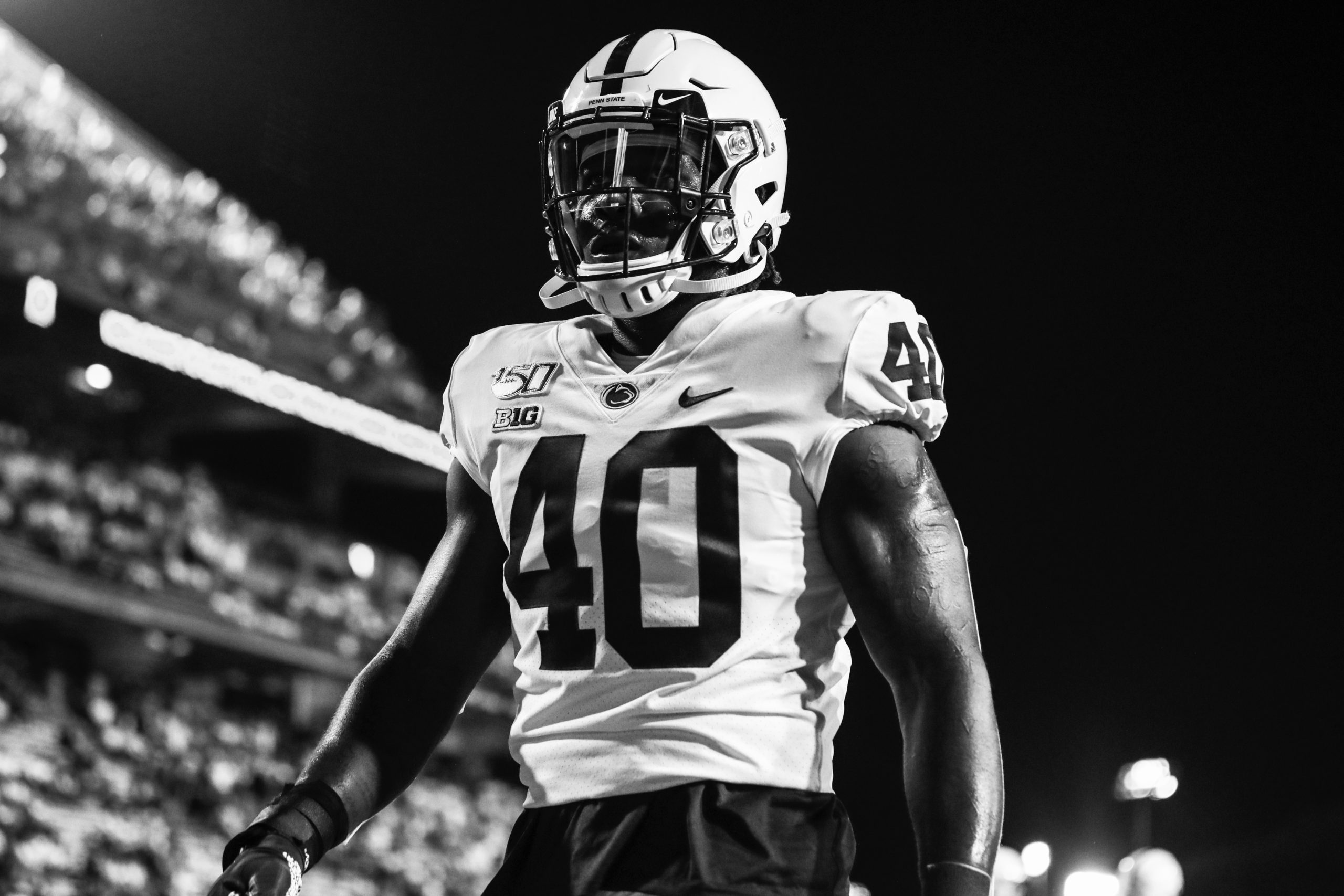
“Seeing some individuals who were forced to stop playing the game they love so much because of injuries is something I pray I never have to encounter,” Luketa said. “It’s just a part of the game, injuries are a part of the game, no matter what sport you’re playing.”
Photos provided by Pennsylvania State Football.


